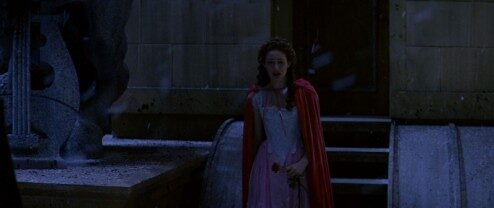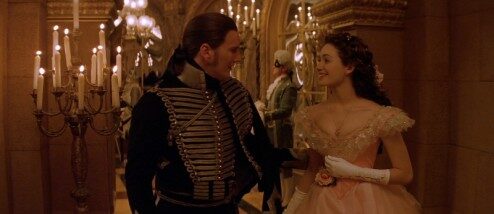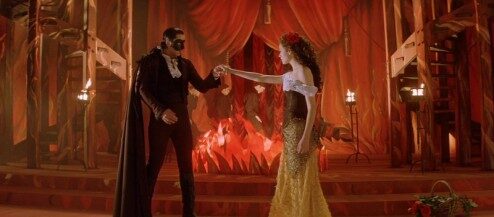The Phantom of the Opera: Colour, Character and Costume |
The Phantom of the Opera (2004, directed by Joel Schumacher) is a lavish depiction of its world, examining the nature of facade – the un-reality of the stage, the masked Phantom of the title, and the duality of “costume” within costume (the majority of clothes on screen are designed as costumes for use in performances in the narrative). Costume designer Alexandra Byrne makes use of symbolic colour palettes and silhouettes to bring this heightened world to life.
We are first taken into the world of the Opera Populaire, 1870, with the dress rehearsal of “Hannibal”. It is interesting to note that not all are wearing full “costume” – corsets and petticoats draw attention to the central performance element. Heroine Christine (Emmy Rossum) is dressed identically to the other dancing girls, in a cream and gold top, cropped below the bust, with heavily embellished gold and blue neckline, embellished waistband with two rows of red pleats at the back and sheer gold skirt with splits. Her partial nudity represents vulnerability. However, soon after this, Christine is transformed to adored soprano – her “costume” an elaborate white full-skirted gown, deep v-neckline coming just off the shoulder, and small puffed sleeves. The change of costume is synonymous with her advanced status. Although revealing less flesh, attention toward her is amplified; she is more an object of desire – now Raoul (Patrick Wilson), her childhood sweetheart, finally recognises her. The white of her gown sets a precedent for a colour palette that serves the character throughout the film. Both her prospective lovers watch her performance, Raoul from above in a box, the Phantom (Gerard Butler) hidden below the stage. Both men’s clothes have accents of white – Raoul’s cravat, shirt and waistcoat, and the Phantom’s mask – tentatively linking them to Christine through their sartorial similarities.
Christine then undresses to her white corset, lace underskirt, gown and stockings. As the Phantom’s voice rings out, an overhead shot displays the gown’s train, highlighting her within the darkness of the room. The diminished size of her clothing as compared to her opera dress demonstrates her vulnerability, and the omnipotence of the Phantom, forbidding yet enticing in his bone-coloured mask and long, black opera cloak. Wearing a topcoat with a large, fur shawl collar, Raoul frantically pounds on the door; now it is his formality and social standing that cast him out as belonging to a different world.
As Christine tentatively gives her hand to the Phantom, the white lace of her sleeve strongly contrasts with his black leather glove, a visual representation of the corruption of innocence in growing up: the pure versus the passionate, the trusting versus the damaged. These parallels continue throughout the film. In “The Music of the Night”, the Phantom’s black gloved hands caress Christine’s waist, bound in its white, lace embellished corset. This fetishisation of her underwear draws attention to Christine’s newly aroused sexuality, the gown open to reveal her figure. This fine attire, un-characteristic of a chorus girl’s wardrobe, could be construed to have been a part of her stage costume. As such, it transcends the practicalities of everyday clothing, becoming a “costume” of the highly eroticised world of the Phantom.
When we see the Phantom’s clothes clearly for the first time, it is evident that he is not entirely in black; his long cloak is lined with white, his cravat dark brown and his single breasted waistcoat a floral brown silk. These dark hues allow for dramatic contrasts, yet the subtleties show complexity. The Phantom is as much a false creation as the characters performing within the Opera –a disguise for a man who cannot face his reality. As such, his clothing, not least his mask, plays the role of a “costume”, creating a kind of acceptance – even if this acceptance is in the form of fear.
The Phantom is a voyeur, watching Christine through a mirror and the black lace veil he draws between them as she sleeps. For his own security, there must always be a barrier between them, whether a physical or sartorial one, such as his mask. When Christine tears the mask from his face on awakening, not just his soul, but his clothing are in disarray. He wears his shirt open, the white frill emphasising the vulnerability of his bare chest.
In the musical number “All I Ask”, Christine’s bold red cloak, fastened with a bow at the neck, is a powerful reminder of the turmoil and blood of the murder of Buquet, and, as the scene progresses, of her love for Raoul. Raoul and the Phantom are both dressed in colours dictated by formal evening dress of the period – most conspicuously black and white. This effective core colour palette of black, white and red underlines the importance of key moments. In a musical where intimate scenes run consecutive to huge Operas and Ballets, considered use of colour is paramount. Significant, bold key colours in scenes with two or three people create a resonance with the larger crowd scenes.
Rich, strong colours also make a strong statement within the wardrobe of Carlotta (Minnie Driver.) As the diva ousted by Christine, her character is both demanding, and insecure, jealously struggling to retain her role as star of the Opera Populaire. She is not a personality to be ignored, and indeed her opulent costumes, festooned with feathers and dripping with jewels, make this impossible. Colours employed include gold, royal blue, bright red, rich purple, pink and black. With the greatest variety of colour, her exaggerated persona, shaped through a life on the stage, is brought to life. In the musical number “Prima Donna”, she is shown dressing (or being dressed), being fussed over in a pink gown trimmed with feathers, having her heavily embellished corset laced for her and her silk slippers used to drink from, before an overpoweringly pink dress, resplendent with huge panniers, is lowered down onto her – the costume transforming the woman into the singing legend.
A scene pivotal in a film obsessed with deception is the Masquerade ball. Masked dancers are clad mainly in black, white, gold and silver. Raoul wears a dark navy military uniform with gold braiding and stand collar, matching short jacket over one shoulder, a classic hero. Christine’s pale pink, full skirted gown and white gloves depict her as a fairy tale princess. It is into this world of ideal perfection that the Phantom bursts, his red, embroidered jacket, breeches and cloak jarring with the soft colours, his mask extended to obscure even more of his face.
Red, white and black is employed in the graveyard scene, with blood being spilled onto a white shirt, and again within “Don Juan”. The dancers are in black and red, while Christine wears a white lace camisole, black under-bust corset, and gold open weave shawl as a skirt, her bare neck and shoulders accentuating sexuality. The Phantom is now in a black mask, and as his bare hand caresses her waist in the black corset, we see a reversal of the striking image of “Music of the Night”, illustrating progression of the character. As this is the Phantom’s opera, it could be read as his vision of Christine. Yet when he kidnaps her, he immediately has her change into a pure white wedding dress; his fascination is with her virtue.
The finale comes as Raoul rushes down a stone staircase to rescue Christine, stripping off jacket and waistcoat as he goes. He is more dynamic without the constraints of his social attire. However, his clothes are soon soaked through, creating the main distinction between him and the Phantom, now dressed exceedingly similarly; as Christine enters the water to save Raoul, the wedding dress billows out around her, the dramatic silhouette marking her influence at this pivotal point.
Silhouette and movement of fabric can tell a story in themselves, as is demonstrated clearly in Phantom of the Opera. The size and shape of a character’s clothes can communicate on a subliminal level, as can the use of a carefully selected colour palette. With many characters dressed in “costume” rather than clothing, these garments seamlessly help us accept a world where people regularly burst into song.
By Bonnie Radcliffe.
Bonnie loves clothes and their power to transform and create characters. She has worked in a variety of roles in costume for film, television and theatre, and wants to share her love for the power of costume design through her writing.
You can watch Emily Rossum in The Phantom of the Opera at LOVEFiLM.com.
© 2012, Contributor.










